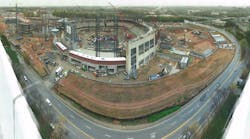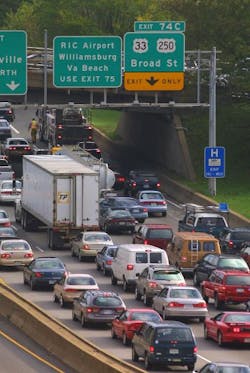The data and analysis used by the American Transportation Research Institute (ATRI) to craft its annual freight highway bottleneck list can also be used to more effectively target roadway funding – especially if President Trump follows through on his infrastructure spending proposals.
In a conference call with reporters to discuss the group’s 2017 Top Truck Bottleneck List, Rebecca Brewster, ATRI’s president and COO, and Dan Murray, ATRI’s vice president, noted that their organization has been gathering GPS data from 600,000-plus heavy duty trucks and tying it back to 250 locations on the national highway system since 2010.
“We use that data to target [congestion] locations for our friends in the public sector for [roadway] investments,” said Brewster. “Our hope is that when infrastructure funding decisions are made, this data will be used to target the most critical areas.”
Murray added that no matter how large the Trump administration’s final infrastructure bill might be – $500 billion or even $ 1 trillion – when you get down to it, there will never be enough money to get every bridge and road fixed.
“So this data is a great targeting device,” he stressed. “Our data indicates that 89% of truck delays are associated with just 12% of the miles trucks travel. So there’s a huge targeting opportunity to address the main cause of truck delays; it allows for the development of a quick blueprint for [infrastructure] investments.”
For motor carriers, Brewster told Fleet Owner they can use this congestion data to analyze lanes of traffic proffered by a new customer. “If the customer wants 3 pm delivery right at peak congestion times, they’ll see that’s a problem and so can negotiate expectations,” she said.
Murray added that, at the other end of this continuum, telematics providers are using ATRI’s bottleneck data to develop more “customized” routing; cobbling together routes by time-of-day data to avoid congestion trouble spots.
“It allows fleets to re-route or re-schedule themselves around chokepoints,” he said. “It also helps the providers develop roadmaps that avoid particular peak hour travel times.”
Murray added another key point extracted from ATRI’s analysis of bottleneck data: there can be a “huge variability” in travel times, even among the top 10 to 15 congestion hot spots.
“There is huge variability between peak and off-peak travel times, which can result in a 40% to 50% drop in vehicle speeds,” he said.
Murray noted, however, that while ATRI’s yearly study identifies freight highway bottlenecks, it’s based solely on truck GPS data, so it cannot always be used to successfully target all traffic congestion hotspots.
“If there are no trucks allowed along a particular stretch of highway – say due to a truck ban – then we won’t record congestion data in that case; we won’t have data on it,” Murray said. “These bottlenecks reflect the impact of congestion on truck travel, but it doesn’t reflect car density.”
The system also can’t necessarily identify the exact reasons why freight congestion occurs at particular spots, either, he pointed out.
“Truth be told, it is difficult to understand the precise causes of congestion based on this data: is it [highway] reconstruction work? Is it the weather?” Murray said. “Over the last two to three years, in some cases, it’s been the improving economy; we cross-reference our traffic data with economic data and can clearly see that trend.”
Other more specific reasons present themselves, too, added Brewster, who noted that traffic volumes at the ninth worst freight chokepoint in the nation, I-75 at I-285 North outside of her hometown of Atlanta, GA, is in part due to the construction of a new stadium for the Atlanta Braves major league baseball team. The stadium is also just 13 miles from the infamous "Spaghetti Junction," single worst freight bottleneck point in the U.S., where Interstates 285 and 85 North meet outside Atlanta.
“We’ll have to wait and see what will happen on game day in terms of traffic congestion,” Brewster said. “I’m sure we’ll see the impact of that [stadium] for many years to come.”




